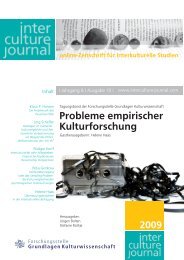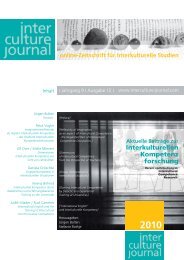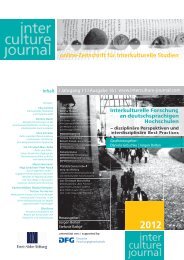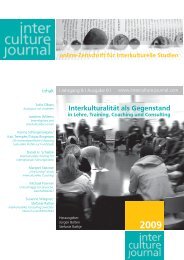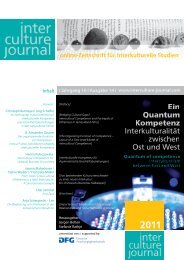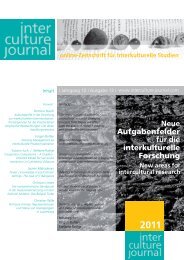Aktuelle Anwendungsfälle Interkultureller Kommunikation | Current ...
Aktuelle Anwendungsfälle Interkultureller Kommunikation | Current ...
Aktuelle Anwendungsfälle Interkultureller Kommunikation | Current ...
Erfolgreiche ePaper selbst erstellen
Machen Sie aus Ihren PDF Publikationen ein blätterbares Flipbook mit unserer einzigartigen Google optimierten e-Paper Software.
Dehmel / Li / Sloane: Intercultural competence development in higher education study abroad<br />
programs: A good practice example<br />
4.4.2. Critical incidents technique<br />
The concept of „critical incidents” was introduced and firstly<br />
applied in the field of cross-cultural psychology by the three<br />
American scholars Fred Fiedler, Terence Mitchell and Harry<br />
Triandis (1971, in Layes 2007:384). They conceived critical<br />
incidents as critical situations which are „conflictful, puzzling”<br />
(for Americans), and which are likely to be „misinterpreted”<br />
but „can be interpreted in a fairly unequivocal manner,<br />
given sufficient knowledge about the culture” (Fiedler et<br />
al. 1971:97 in Layes 2007:384). Later, their concept of critical<br />
incidents has been used as the basis for the so-called „culture<br />
assimilator” approach in intercultural training programs. It<br />
employs the critical incident approach and provides participants<br />
with various cross-cultural interactions and potential<br />
misunderstandings between individuals from different cultures.<br />
The participants are asked to choose from a range of<br />
alternative explanations for each incident. Each explanation<br />
represents a different attribution concerning the causes of<br />
behaviour. The participants are usually asked to explain the<br />
perceived problem from the perspectives of the counter partners’<br />
cultural view (Cushner / Brislin 1996:22ff.). The most<br />
well-known work in this field is „Intercultural interactions: a<br />
practical guide” by Cushner and Brislin (1994, 2000). In their<br />
work, critical incidents are collected, analysed, re-designed<br />
and explained by experts, and compiled in 18 thematic categories.<br />
In Germany, well-received work was done by Alexander<br />
Thomas, who was the first to introduce the concept of<br />
„kritische Interaktionssituationen” (critical situations of interactions,<br />
critical incidents) into the German context (1993, cf.<br />
Layes 2007:384) [17].<br />
In the framework of the ASBE program, the critical incident<br />
technique has been modified and adapted in order to meet<br />
the specific characteristics and aims of this particular program.<br />
As described below, the concept of critical incidents is<br />
used to investigate where and when misunderstandings, irritations,<br />
avoidance, conflicts or other difficulties occurred in<br />
the students’ daily encounters, and to systematically analyse<br />
and reflect upon them.<br />
4.4.3. The combined approach of the ASBE program<br />
In order to promote the development of intercultural competence<br />
in the ASBE program, the critical incidents technique<br />
and the ideas of experiential and reflective learning have<br />
been adapted and combined (see also fig. 4). They are integrated<br />
in the overall ASBE framework.<br />
As an important element of the workshop intercultural communication<br />
and competence in the first phase of the ASBE<br />
25 © Interculture Journal 2011 | 15



